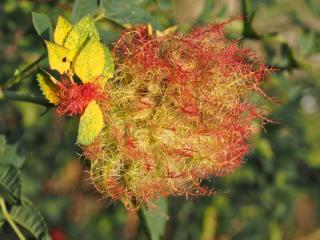

Gall wasp is an insect that lays eggs in soft tissues in trees, flowers and other plants. As the larvae develop, a gall forms and hinders plant growth.
Gall wasp general facts
Name: Cynips, Diplolepis, Neuroterus…
Common name: gall wasp
Appears in: spring to summer
Type: insect (wasp) – Spread: worldwide – Infects: shoots, leaves, buds
Size: 1/16th of an inch (2 mm) → 1/3rd of an inch (8 mm), depending on species
Generations per year – variable, up to a half-dozen
Usually, a single given insect will only contaminate a single plant species, or at most only members of the same plant family. In severe cases, the harvest is compromised and the plant may die.
Read also:
There are different kinds of gall wasp, and their impact on host species also differs, but there is one symptom that all have in common. They all cause galls!
 A gall is a swelling of tissue such as leaf tissue, bark tissue, or bud tissue resulting from infection by a gall wasp.
A gall is a swelling of tissue such as leaf tissue, bark tissue, or bud tissue resulting from infection by a gall wasp.→ Good to know: galls are for the larvae. Adult gall wasps often feed on nectar or other food. They make great pollinators.
 A gall wasp is a flying insect of the same family as the common wasp. It has the particularity of requiring a specific host plant as part of its reproductive cycle.
A gall wasp is a flying insect of the same family as the common wasp. It has the particularity of requiring a specific host plant as part of its reproductive cycle.
For example, the citrus gall wasp will only infect citrus trees. Other plants and trees will not be infected by it. If no citrus tree is available, the citrus gall wasp will not be able to reproduce. Originally, it only infected finger lime, but when other citrus trees were introduced, it infected those, too.
Usually, a gall becomes visible to the eye around 1 to 6 weeks after the eggs were laid.
Every day, botanists and entomologists discover new species. Only a fraction of all possible gall wasp and host plant relationships are know and described so far.
In gardens throughout the world, all types and families of plants have been known to support at least one or more gall wasps.
 Rose gall wasp – mossy rose gall and spiny rose gall are both due to gallflies that infect rose shrubs.
Rose gall wasp – mossy rose gall and spiny rose gall are both due to gallflies that infect rose shrubs. People often prefer to let nature do its work, since gall wasps rarely take over an entire tree. Typical natural ways to control gall wasp involve predators that feed on gall wasp larvae.
People often prefer to let nature do its work, since gall wasps rarely take over an entire tree. Typical natural ways to control gall wasp involve predators that feed on gall wasp larvae.
When natural predators aren’t common, manual removal is also very effective. Pruning off the gall-infected branches and leaves and then burning them works best when the timing is right: the new generation of wasps should not have emerged yet.
Over 1400 species of gall wasps have been identified and catalogued to date. This doesn’t include other types of galls, such as those due to fungus or mites.
Each wasp is usually specific to a single host plant species. This is because the chemical cocktail required to trigger gall formation is unique to each plant species.
 In the course of time, each parasite wasp evolved to produce exactly the mix that would trigger the “ideal” gall for it. This would afford the hatched pupa protection, food and safety from predators.
In the course of time, each parasite wasp evolved to produce exactly the mix that would trigger the “ideal” gall for it. This would afford the hatched pupa protection, food and safety from predators.
Some gall wasp species only lay eggs where other gall wasps have laid them, in the gall. They then benefit from the gall without having had to trigger it. These are called inquiline gall wasp. Usually they out-compete the original gall wasp for nutrients, much like a cuckoo replaces its siblings in the host bird nest.
Gall wasps won’t sting persons or animals. Their sting isn’t designed for attack, it’s actually simply a tube that lays eggs. It can pierce through woody tissue but the wasp won’t use it to defend itself.
 These are so tiny, bring a magnifying glass out when you are on the lookout for them!
These are so tiny, bring a magnifying glass out when you are on the lookout for them!
Indeed, the largest are only a few millimeters long (¼ inch). Another fitting name for them is “gallfly” or “gallflies”.
A sharp blade can slice open galls, revealing parasites inside.
I’m curious as to whether green ants, as we call them in tropical Queensland, would control Gall Wasps.
These ants are very aggressive to humans but I have noticed no damage to citrus from fruit fly when these ants are present in the trees. They build a nest approximately 150mm in diameter by pulling the leaves together. It’s fascinating to watch them working.
That definitely sounds like a possibility to control gall wasps! Ants ferociously defend their territory against other insects. Perhaps the gall wasps don’t dare to risk their offspring in such trees!
Certainly the trade-off would be interesting to estimate: risk to orchard workers by ants vs better health in trees!